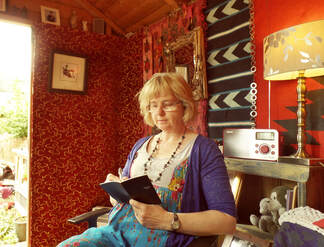Session 1: How to be a writer
|
NOTE: Some people find writing things down really difficult for one reason or another. If you’re one of those people, perhaps you could try using the voice recorder on a smartphone or tablet instead, or even ask someone else to write things down for you. You might be better at doodling, and if so, you could illustrate your ideas and your eventual story.
Tip – The timings for each part of the workshop are only a suggestion: take as long as you need.
Hint – you should spend longer than you think you need for each activity and dig as deeply as you can into your imagination, there is no need to rush, and you will find there is so much more in there than you think.
Hint – you should spend longer than you think you need for each activity and dig as deeply as you can into your imagination, there is no need to rush, and you will find there is so much more in there than you think.
Do you have a brand new notebook at hand? This will really help you begin your journey into becoming a writer.
If not, you can use scrap paper, or any paper, and fasten it into a notebook later.
If not, you can use scrap paper, or any paper, and fasten it into a notebook later.

Intro 10 mins.
Take a few minutes to consider some of your favourite writers. Jot down some of their names, and the titles of their books. The things you like about their writing can help inspire your own work. What did you like about their books? Think about this carefully. Make some notes to remind yourself of how your favourite book made you feel – this will help when you plan your own story because you want to try and make your reader feel the same way.
Now we’re going to think about how to start becoming a writer. We’re going to try getting ‘inside’ the subject, whatever the subject is that you choose. What do you think getting inside the subject means? I’ll give you a clue: it isn’t only describing something, you have to use your imagination in a BIG way and pretend to BE the thing or person you’re writing about.
Let’s begin.
Take a few minutes to consider some of your favourite writers. Jot down some of their names, and the titles of their books. The things you like about their writing can help inspire your own work. What did you like about their books? Think about this carefully. Make some notes to remind yourself of how your favourite book made you feel – this will help when you plan your own story because you want to try and make your reader feel the same way.
Now we’re going to think about how to start becoming a writer. We’re going to try getting ‘inside’ the subject, whatever the subject is that you choose. What do you think getting inside the subject means? I’ll give you a clue: it isn’t only describing something, you have to use your imagination in a BIG way and pretend to BE the thing or person you’re writing about.
Let’s begin.
20 mins.
In this first session of How to be a Writer, I want you to *mind-map* your creativity. Your mind map needs to feature the words: Observe, Explore and Investigate. I think these three things are the foundations of creative practice. You can develop these concepts into ACTIONS such as Look, Listen, Touch, Smell and Feel, both emotionally and physically.
This part is all about your imagination, and converting this to words on paper. Think of different things to describe under each of the above actions: Look – tell me what you can see when you close your eyes and picture your chosen object or subject. Now tell me what you can hear when you listen to it (in your imagination). What does it feel like if you pick it up or lay your hand on it? Write it all down and use as many descriptive words as you can.
I’ll start by giving the example of a marble. Remember that all of this is going to come from my memory and my knowledge of marbles, and a little bit from my imagination, because I don’t have a marble with me right now. We’re exercising our imagination muscles.
Look: the marble is small and round. It’s made of spherical glass and it has a swirl of colour in the centre of the glass. The streak in the middle is shaped like a coloured leaf. When light catches the marble it glitters and reflects the light.
Listen: I can’t hear anything when I hold the marble to my ear but if I roll the marble along a wooden floor I know I’ll hear a hollow, rolling sound. A deep sound, almost like thunder. I know this from memory. What can you remember, or imagine, about the thing you’re writing about?
Touch: the marble feels cold and smooth in my hand. It’s hard when I hold it between my finger and my thumb. There might be a little nick in the surface of the marble that feels rough and as if it might cut my finger if I rub it the wrong way on my skin.
Adding specific details like this to your description will make it more personal and help the reader’s imagination. Try and add a specific detail to your Look/Listen/Touch/Smell and Feel descriptions.
Smell: the marble has a mixture of smells. I’m going to imagine I’ve taken it out of a dusty jar on a high shelf, and so it has an old smell of dust. It might make me sneeze. Perhaps I can also smell the faint tinge of sweat from all the hands the marble was enclosed within in the past. (I have to stop my imagination running wild now about all the children that might have won the marble from each other during games in the playground, because I need to tackle the next challenge!)
Feel: think about feel in two different ways. Emotional feeling comes from inside. I’m going to say the marble makes me feel nostalgic because I remember collecting marbles when I was a child. Now for the other kind of feel. The physical feel of the marble. The marble feels quite heavy in the palm of my hand. My imagination is going to make it larger than I at first thought. During creative writing you can change your mind about what you were going to say. You can rewrite as you go along, but after you finish writing your first draft, you’ll have to do something called editing, which we’ll explore in a later session.
In this first session of How to be a Writer, I want you to *mind-map* your creativity. Your mind map needs to feature the words: Observe, Explore and Investigate. I think these three things are the foundations of creative practice. You can develop these concepts into ACTIONS such as Look, Listen, Touch, Smell and Feel, both emotionally and physically.
This part is all about your imagination, and converting this to words on paper. Think of different things to describe under each of the above actions: Look – tell me what you can see when you close your eyes and picture your chosen object or subject. Now tell me what you can hear when you listen to it (in your imagination). What does it feel like if you pick it up or lay your hand on it? Write it all down and use as many descriptive words as you can.
I’ll start by giving the example of a marble. Remember that all of this is going to come from my memory and my knowledge of marbles, and a little bit from my imagination, because I don’t have a marble with me right now. We’re exercising our imagination muscles.
Look: the marble is small and round. It’s made of spherical glass and it has a swirl of colour in the centre of the glass. The streak in the middle is shaped like a coloured leaf. When light catches the marble it glitters and reflects the light.
Listen: I can’t hear anything when I hold the marble to my ear but if I roll the marble along a wooden floor I know I’ll hear a hollow, rolling sound. A deep sound, almost like thunder. I know this from memory. What can you remember, or imagine, about the thing you’re writing about?
Touch: the marble feels cold and smooth in my hand. It’s hard when I hold it between my finger and my thumb. There might be a little nick in the surface of the marble that feels rough and as if it might cut my finger if I rub it the wrong way on my skin.
Adding specific details like this to your description will make it more personal and help the reader’s imagination. Try and add a specific detail to your Look/Listen/Touch/Smell and Feel descriptions.
Smell: the marble has a mixture of smells. I’m going to imagine I’ve taken it out of a dusty jar on a high shelf, and so it has an old smell of dust. It might make me sneeze. Perhaps I can also smell the faint tinge of sweat from all the hands the marble was enclosed within in the past. (I have to stop my imagination running wild now about all the children that might have won the marble from each other during games in the playground, because I need to tackle the next challenge!)
Feel: think about feel in two different ways. Emotional feeling comes from inside. I’m going to say the marble makes me feel nostalgic because I remember collecting marbles when I was a child. Now for the other kind of feel. The physical feel of the marble. The marble feels quite heavy in the palm of my hand. My imagination is going to make it larger than I at first thought. During creative writing you can change your mind about what you were going to say. You can rewrite as you go along, but after you finish writing your first draft, you’ll have to do something called editing, which we’ll explore in a later session.

20 mins.
Describe three objects, places, people or imaginary creatures, one after the other, using all of your senses. The purpose of this exercise is to get you into the habit of writing that way.
Now choose one thing that you want to especially concentrate on, that you will later incorporate into a story.
I am going to use the example of a tree. Your chosen subject could be something completely different. So in my example, when I say tree, you can think about the thing or place, or even person, you’ve chosen.
Look at that tree, listen to the sound of its branches in the wind; touch the bark of its trunk and press your nose to it: breathe in its scent. Now put your arms around the tree and feel the shape of it. Lay your head against the trunk and explore your emotions. Does the tree make you feel peaceful, relaxed, sad or happy? All of this must come from your IMAGINATION.
This imaginary tree (or whatever subject you decide on) is now your INSPIRATION for a piece of creative writing. Describe the shape of the tree. What sound does its branches make? What is the texture of its trunk? Describe the smell of the tree. How does it feel to put your arms around it?
Maybe you’re writing about a book. Describe the smell of the book, the rustle its pages make when you turn them, the magic of the story within. How would it feel to be INSIDE that story?
Before the next session I want you to find an actual tree (or the thing you’ve chosen – it could be a car or a shed or a rock in the garden, or something much smaller – whatever takes your imagination!) It might be something in the house, a toy or book or a tin full of secret treasures – it could even be a special place in the house, like a corner you love to hide in or a windowsill you like to sit on. Now do all the things in real life that I asked you to do in your imagination: Look, Listen, Touch, Smell and Feel. You could then write down what the real thing actually looks, feels, smells and sounds like and how touching and listening to it makes you feel in real life. This might be different to how it was in your imagination. That shows you how clever your imagination can be. You can combine imagination with things that you know are true in a story.
Describe three objects, places, people or imaginary creatures, one after the other, using all of your senses. The purpose of this exercise is to get you into the habit of writing that way.
Now choose one thing that you want to especially concentrate on, that you will later incorporate into a story.
I am going to use the example of a tree. Your chosen subject could be something completely different. So in my example, when I say tree, you can think about the thing or place, or even person, you’ve chosen.
Look at that tree, listen to the sound of its branches in the wind; touch the bark of its trunk and press your nose to it: breathe in its scent. Now put your arms around the tree and feel the shape of it. Lay your head against the trunk and explore your emotions. Does the tree make you feel peaceful, relaxed, sad or happy? All of this must come from your IMAGINATION.
This imaginary tree (or whatever subject you decide on) is now your INSPIRATION for a piece of creative writing. Describe the shape of the tree. What sound does its branches make? What is the texture of its trunk? Describe the smell of the tree. How does it feel to put your arms around it?
Maybe you’re writing about a book. Describe the smell of the book, the rustle its pages make when you turn them, the magic of the story within. How would it feel to be INSIDE that story?
Before the next session I want you to find an actual tree (or the thing you’ve chosen – it could be a car or a shed or a rock in the garden, or something much smaller – whatever takes your imagination!) It might be something in the house, a toy or book or a tin full of secret treasures – it could even be a special place in the house, like a corner you love to hide in or a windowsill you like to sit on. Now do all the things in real life that I asked you to do in your imagination: Look, Listen, Touch, Smell and Feel. You could then write down what the real thing actually looks, feels, smells and sounds like and how touching and listening to it makes you feel in real life. This might be different to how it was in your imagination. That shows you how clever your imagination can be. You can combine imagination with things that you know are true in a story.
